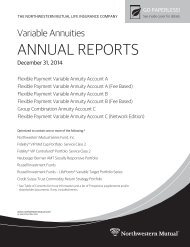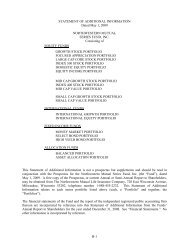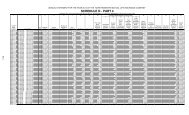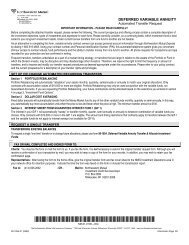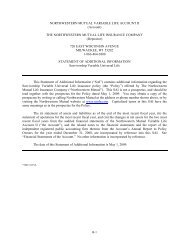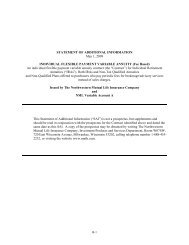- Page 1 and 2: December 31, 2008 THE NORTHWESTERN
- Page 3 and 4: Contents Northwestern Mutual Series
- Page 5 and 6: Annual Report December 31, 2008 Nor
- Page 7 and 8: Northwestern Mutual Series Fund, In
- Page 9 and 10: Expense Examples Beginning Account
- Page 11 and 12: Growth Stock Portfolio Objective: P
- Page 13 and 14: Growth Stock Portfolio Northwestern
- Page 15 and 16: Focused Appreciation Portfolio Obje
- Page 17: Focused Appreciation Portfolio Nort
- Page 21 and 22: Large Cap Core Stock Portfolio Comm
- Page 23 and 24: Large Cap Blend Portfolio companies
- Page 25 and 26: Large Cap Blend Portfolio Common St
- Page 27 and 28: Index 500 Stock Portfolio massive g
- Page 29 and 30: Index 500 Stock Portfolio Common St
- Page 31 and 32: Index 500 Stock Portfolio Common St
- Page 33 and 34: Large Company Value Portfolio Objec
- Page 35 and 36: Large Company Value Portfolio North
- Page 37 and 38: Domestic Equity Portfolio Objective
- Page 39 and 40: Domestic Equity Portfolio Northwest
- Page 41 and 42: Equity Income Portfolio Objective:
- Page 43 and 44: Equity Income Portfolio Northwester
- Page 45 and 46: Equity Income Portfolio * Non-Incom
- Page 47 and 48: Mid Cap Growth Stock Portfolio Outl
- Page 49 and 50: Mid Cap Growth Stock Portfolio * No
- Page 51 and 52: Index 400 Stock Portfolio greater d
- Page 53 and 54: Index 400 Stock Portfolio Common St
- Page 55 and 56: Index 400 Stock Portfolio Common St
- Page 57 and 58: Mid Cap Value Portfolio Sub-Adviser
- Page 59 and 60: Mid Cap Value Portfolio Common Stoc
- Page 61 and 62: Small Cap Growth Stock Portfolio Re
- Page 63 and 64: Small Cap Growth Stock Portfolio Co
- Page 65 and 66: Index 600 Stock Portfolio Objective
- Page 67 and 68: Index 600 Stock Portfolio Northwest
- Page 69 and 70:
Index 600 Stock Portfolio Common St
- Page 71 and 72:
Index 600 Stock Portfolio Common St
- Page 73 and 74:
Small Cap Value Portfolio Objective
- Page 75 and 76:
Small Cap Value Portfolio Northwest
- Page 77 and 78:
Small Cap Value Portfolio Common St
- Page 79 and 80:
International Growth Portfolio expe
- Page 81 and 82:
International Growth Portfolio Fore
- Page 83 and 84:
International Growth Portfolio Shor
- Page 85 and 86:
Research International Core Portfol
- Page 87 and 88:
Research International Core Portfol
- Page 89 and 90:
International Equity Portfolio Outl
- Page 91 and 92:
International Equity Portfolio Fore
- Page 93 and 94:
Emerging Markets Equity Portfolio O
- Page 95 and 96:
Emerging Markets Equity Portfolio N
- Page 97 and 98:
Emerging Markets Equity Portfolio F
- Page 99 and 100:
Money Market Portfolio Outlook As t
- Page 101 and 102:
Money Market Portfolio Money Market
- Page 103 and 104:
Short-Term Bond Portfolio A key pos
- Page 105 and 106:
Short-Term Bond Portfolio Northwest
- Page 107 and 108:
Short-Term Bond Portfolio Structure
- Page 109 and 110:
Select Bond Portfolio Outlook We re
- Page 111 and 112:
Select Bond Portfolio Northwestern
- Page 113 and 114:
Select Bond Portfolio Corporate Bon
- Page 115 and 116:
Select Bond Portfolio Corporate Bon
- Page 117 and 118:
Select Bond Portfolio Governments (
- Page 119 and 120:
Select Bond Portfolio Structured Pr
- Page 121 and 122:
Select Bond Portfolio (a) (b) At De
- Page 123 and 124:
Long-Term U.S. Government Bond Port
- Page 125 and 126:
Long-Term U.S. Government Bond Port
- Page 127 and 128:
Long-Term U.S. Government Bond Port
- Page 129 and 130:
Inflation Protection Portfolio Obje
- Page 131 and 132:
Inflation Protection Portfolio Top
- Page 133 and 134:
Inflation Protection Portfolio Gove
- Page 135 and 136:
High Yield Bond Portfolio Objective
- Page 137 and 138:
High Yield Bond Portfolio Top 10 Fi
- Page 139 and 140:
High Yield Bond Portfolio Bonds (88
- Page 141 and 142:
High Yield Bond Portfolio Bonds (88
- Page 143 and 144:
Multi-Sector Bond Portfolio Objecti
- Page 145 and 146:
Multi-Sector Bond Portfolio The Por
- Page 147 and 148:
Multi-Sector Bond Portfolio Corpora
- Page 149 and 150:
Multi-Sector Bond Portfolio Municip
- Page 151 and 152:
Multi-Sector Bond Portfolio (a) (b)
- Page 153 and 154:
Balanced Portfolio Objective: Portf
- Page 155 and 156:
Balanced Portfolio Top 5 Equity Hol
- Page 157 and 158:
Balanced Portfolio Domestic Common
- Page 159 and 160:
Balanced Portfolio Domestic Common
- Page 161 and 162:
Balanced Portfolio Foreign Common S
- Page 163 and 164:
Balanced Portfolio Foreign Common S
- Page 165 and 166:
Balanced Portfolio Shares/ $ Par Va
- Page 167 and 168:
Balanced Portfolio Shares/ $ Par Va
- Page 169 and 170:
Balanced Portfolio Structured Produ
- Page 171 and 172:
Balanced Portfolio Shares/ $ Par Va
- Page 173 and 174:
Balanced Portfolio Short-Term Inves
- Page 175 and 176:
Balanced Portfolio CounterParty JPM
- Page 177 and 178:
Asset Allocation Portfolio Outlook
- Page 179 and 180:
Asset Allocation Portfolio Northwes
- Page 181 and 182:
Asset Allocation Portfolio Domestic
- Page 183 and 184:
Asset Allocation Portfolio Domestic
- Page 185 and 186:
Asset Allocation Portfolio Foreign
- Page 187 and 188:
Asset Allocation Portfolio Shares/
- Page 189 and 190:
Asset Allocation Portfolio Shares/
- Page 191 and 192:
Asset Allocation Portfolio Structur
- Page 193 and 194:
Asset Allocation Portfolio Shares/
- Page 195 and 196:
Asset Allocation Portfolio Shares/
- Page 197 and 198:
Benchmark Definitions The following
- Page 199 and 200:
Benchmark Definitions S&P 500 Index
- Page 201 and 202:
Large Company Value Portfolio Domes
- Page 203 and 204:
Short-Term Bond Portfolio Select Bo
- Page 205 and 206:
Northwestern Mutual Series Fund, In
- Page 207 and 208:
Northwestern Mutual Series Fund, In
- Page 209 and 210:
Large Cap Blend Portfolio Index 500
- Page 211 and 212:
Mid Cap Value Portfolio For the Yea
- Page 213 and 214:
Emerging Markets Equity Portfolio F
- Page 215 and 216:
Multi-Sector Bond Portfolio Balance
- Page 217 and 218:
Total Return (d) Net Assets, End of
- Page 219 and 220:
Total Return (d) Net Assets, End of
- Page 221 and 222:
Total Return (d) Net Assets, End of
- Page 223 and 224:
Total Return (d) Net Assets, End of
- Page 225 and 226:
Notes to Financial Statements Portf
- Page 227 and 228:
Notes to Financial Statements futur
- Page 229 and 230:
Notes to Financial Statements maxim
- Page 231 and 232:
Notes to Financial Statements Level
- Page 233 and 234:
Notes to Financial Statements First
- Page 235 and 236:
Notes to Financial Statements may a
- Page 237 and 238:
Notes to Financial Statements Portf
- Page 239 and 240:
Notes to Financial Statements The P
- Page 241 and 242:
Proxy Voting and Portfolio Holdings
- Page 243 and 244:
Director and Officer Information (U
- Page 245 and 246:
Approval and Continuance of Investm
- Page 247 and 248:
Approval and Continuance of Investm
- Page 249 and 250:
Approval and Continuance of Investm
- Page 251 and 252:
VIP Mid Cap Initial Class S&P MidC
- Page 253 and 254:
VIP Mid Cap Initial Class S&P MidC
- Page 255 and 256:
VIP Mid Cap Initial Class S&P MidC
- Page 257 and 258:
VIP Mid Cap Initial Class S&P MidC
- Page 259 and 260:
VIP Mid Cap Initial Class S&P MidC
- Page 261 and 262:
VIP Mid Cap Initial Class S&P MidC
- Page 263 and 264:
VIP Mid Cap Initial Class S&P MidC
- Page 265 and 266:
VIP Mid Cap Initial Class S&P MidC
- Page 267 and 268:
VIP Mid Cap Initial Class S&P MidC
- Page 269 and 270:
VIP Mid Cap Initial Class S&P MidC
- Page 271 and 272:
VIP Mid Cap Initial Class S&P MidC
- Page 273 and 274:
VIP Mid Cap Initial Class S&P MidC
- Page 275 and 276:
VIP Mid Cap Initial Class S&P MidC
- Page 277 and 278:
ÁÁÁÁÁÁÁÁÁÁÁÁÁÁÁÁÁ
- Page 279 and 280:
ÁÁÁÁÁÁÁÁÁÁÁÁÁÁÁÁÁ
- Page 281 and 282:
ÁÁÁÁÁÁÁÁÁÁÁÁÁÁÁÁÁ
- Page 283 and 284:
ÁÁÁÁÁÁÁÁÁÁÁÁÁÁÁÁÁ
- Page 285:
ÁÁÁÁÁÁÁÁÁÁÁÁÁÁÁÁÁ
- Page 289 and 290:
ÁÁÁÁÁÁÁÁÁÁÁÁÁÁÁÁÁ
- Page 291 and 292:
VIP Contrafund Initial Class S&P 5
- Page 293 and 294:
VIP Contrafund Initial Class S&P 5
- Page 295 and 296:
VIP Contrafund Initial Class S&P 5
- Page 297 and 298:
VIP Contrafund Initial Class S&P 5
- Page 299 and 300:
VIP Contrafund Initial Class S&P 5
- Page 301 and 302:
VIP Contrafund Initial Class S&P 5
- Page 303 and 304:
VIP Contrafund Initial Class S&P 5
- Page 305 and 306:
VIP Contrafund Initial Class S&P 5
- Page 307 and 308:
VIP Contrafund Initial Class S&P 5
- Page 309 and 310:
VIP Contrafund Initial Class S&P 5
- Page 311 and 312:
VIP Contrafund Initial Class S&P 5
- Page 313 and 314:
VIP Contrafund Initial Class S&P 5
- Page 315 and 316:
VIP Contrafund Initial Class S&P 5
- Page 317 and 318:
ÁÁÁÁÁÁÁÁÁÁÁÁÁÁÁÁÁ
- Page 319 and 320:
ÁÁÁÁÁÁÁÁÁÁÁÁÁÁÁÁÁ
- Page 321 and 322:
ÁÁÁÁÁÁÁÁÁÁÁÁÁÁÁÁÁ
- Page 323 and 324:
ÁÁÁÁÁÁÁÁÁÁÁÁÁÁÁÁÁ
- Page 328 and 329:
ÁÁÁÁÁÁÁÁÁÁÁÁÁÁÁÁÁ
- Page 330 and 331:
Socially Responsive Portfolio Manag
- Page 332 and 333:
Endnotes 1 “Total Return” inclu
- Page 334 and 335:
Schedule of Investments Socially Re
- Page 336 and 337:
Notes to Schedule of Investments So
- Page 338 and 339:
Statement of Assets and Liabilities
- Page 340 and 341:
Statements of Changes in Net Assets
- Page 342 and 343:
transactions. Net unrealized foreig
- Page 344 and 345:
Net income from the lending program
- Page 346 and 347:
Note D—Fund Share Transactions: S
- Page 348 and 349:
Financial Highlights Socially Respo
- Page 350 and 351:
Notes to Financial Highlights Socia
- Page 352 and 353:
Trustee and Officer Information The
- Page 354 and 355:
Name, (Year of Birth), Position and
- Page 356 and 357:
Name, (Year of Birth), Position and
- Page 358 and 359:
Information about the Officers of t
- Page 360 and 361:
Name, (Year of Birth), Position and
- Page 362 and 363:
potential economies of scale for th
- Page 364 and 365:
and/or new Sub-Advisory Agreement w
- Page 366 and 367:
[THIS PAGE INTENTIONALLY LEFT BLANK
- Page 368 and 369:
Russell Investment Funds Russell In
- Page 370 and 371:
Russell Investment Funds Copyright
- Page 372 and 373:
Russell Investment Funds Market Sum
- Page 374 and 375:
Russell Investment Funds services s
- Page 376 and 377:
Russell Investment Funds impact on
- Page 378 and 379:
Russell Investment Funds Multi-Styl
- Page 380 and 381:
Russell Investment Funds Multi-Styl
- Page 382 and 383:
Russell Investment Funds Multi-Styl
- Page 384 and 385:
Russell Investment Funds Multi-Styl
- Page 386 and 387:
Russell Investment Funds Multi-Styl
- Page 388 and 389:
Russell Investment Funds Aggressive
- Page 390 and 391:
Russell Investment Funds Aggressive
- Page 392 and 393:
Russell Investment Funds Aggressive
- Page 394 and 395:
Russell Investment Funds Aggressive
- Page 396 and 397:
Russell Investment Funds Aggressive
- Page 398 and 399:
Russell Investment Funds Aggressive
- Page 400 and 401:
Russell Investment Funds Aggressive
- Page 402 and 403:
Russell Investment Funds Aggressive
- Page 404 and 405:
Russell Investment Funds Non-U.S. F
- Page 406 and 407:
Russell Investment Funds Non-U.S. F
- Page 408 and 409:
Russell Investment Funds Non-U.S. F
- Page 410 and 411:
Russell Investment Funds Non-U.S. F
- Page 412 and 413:
Russell Investment Funds Non-U.S. F
- Page 414 and 415:
Russell Investment Funds Non-U.S. F
- Page 416 and 417:
Russell Investment Funds Non-U.S. F
- Page 418 and 419:
Russell Investment Funds Non-U.S. F
- Page 420 and 421:
Russell Investment Funds Core Bond
- Page 422 and 423:
Russell Investment Funds Core Bond
- Page 424 and 425:
Russell Investment Funds Core Bond
- Page 426 and 427:
Russell Investment Funds Core Bond
- Page 428 and 429:
Russell Investment Funds Core Bond
- Page 430 and 431:
Russell Investment Funds Core Bond
- Page 432 and 433:
Russell Investment Funds Core Bond
- Page 434 and 435:
Russell Investment Funds Core Bond
- Page 436 and 437:
Russell Investment Funds Core Bond
- Page 438 and 439:
Russell Investment Funds Core Bond
- Page 440 and 441:
Russell Investment Funds Core Bond
- Page 442 and 443:
Russell Investment Funds Core Bond
- Page 444 and 445:
Russell Investment Funds Core Bond
- Page 446 and 447:
Russell Investment Funds Core Bond
- Page 448 and 449:
Russell Investment Funds Real Estat
- Page 450 and 451:
Russell Investment Funds Real Estat
- Page 452 and 453:
Russell Investment Funds Real Estat
- Page 454 and 455:
Russell Investment Funds Real Estat
- Page 456 and 457:
Russell Investment Funds Notes to S
- Page 458 and 459:
Russell Investment Funds Statements
- Page 460 and 461:
Russell Investment Funds Statements
- Page 462 and 463:
Russell Investment Funds Financial
- Page 464 and 465:
Russell Investment Funds Notes to F
- Page 466 and 467:
Russell Investment Funds Notes to F
- Page 468 and 469:
Russell Investment Funds Notes to F
- Page 470 and 471:
Russell Investment Funds Notes to F
- Page 472 and 473:
Russell Investment Funds Notes to F
- Page 474 and 475:
Russell Investment Funds Notes to F
- Page 476 and 477:
Russell Investment Funds Notes to F
- Page 478 and 479:
Russell Investment Funds Notes to F
- Page 480 and 481:
Russell Investment Funds Notes to F
- Page 482 and 483:
Report of Independent Registered Pu
- Page 484 and 485:
Russell Investment Funds Basis for
- Page 486 and 487:
Russell Investment Company Basis fo
- Page 488 and 489:
Russell Investment Funds Shareholde
- Page 490 and 491:
Russell Investment Funds Disclosure
- Page 492 and 493:
Russell Investment Funds Disclosure
- Page 494 and 495:
Russell Investment Funds 909 A Stre
- Page 496 and 497:
Russell Investment Funds Russell In
- Page 498 and 499:
Russell Investment Funds - LifePoin
- Page 500 and 501:
Russell Investment Funds Market Sum
- Page 502 and 503:
Russell Investment Funds services s
- Page 504 and 505:
Russell Investment Funds impact on
- Page 506 and 507:
Russell Investment Funds Moderate S
- Page 508 and 509:
Russell Investment Funds Moderate S
- Page 510 and 511:
Russell Investment Funds Moderate S
- Page 512 and 513:
Russell Investment Funds Balanced S
- Page 514 and 515:
Russell Investment Funds Balanced S
- Page 516 and 517:
Russell Investment Funds Balanced S
- Page 518 and 519:
Russell Investment Funds Growth Str
- Page 520 and 521:
Russell Investment Funds Growth Str
- Page 522 and 523:
Russell Investment Funds Growth Str
- Page 524 and 525:
Russell Investment Funds Equity Gro
- Page 526 and 527:
Russell Investment Funds Equity Gro
- Page 528 and 529:
Russell Investment Funds Equity Gro
- Page 530 and 531:
Russell Investment Funds LifePoints
- Page 532 and 533:
Russell Investment Funds LifePoints
- Page 534 and 535:
Russell Investment Funds LifePoints
- Page 536 and 537:
Russell Investment Funds LifePoints
- Page 538 and 539:
Russell Investment Funds LifePoints
- Page 540 and 541:
Russell Investment Funds LifePoints
- Page 542 and 543:
Russell Investment Funds LifePoints
- Page 544 and 545:
Report of Independent Registered Pu
- Page 546 and 547:
Russell Investment Funds LifePoints
- Page 548 and 549:
Russell Investment Funds LifePoints
- Page 550 and 551:
Russell Investment Funds LifePoints
- Page 552 and 553:
Russell Investment Funds LifePoints
- Page 554 and 555:
Russell Investment Funds LifePoints
- Page 556 and 557:
Russell Investment Funds 909 A Stre
- Page 558 and 559:
Northwestern Mutual Series Fund, In
- Page 560 and 561:
THE NORTHWESTERN MUTUAL LIFE INSURA
- Page 562 and 563:
Northwestern Mutual Series Fund, In
- Page 564 and 565:
Small Cap Value Portfolio Effective
- Page 566:
Northwestern Mutual Series Fund, In



